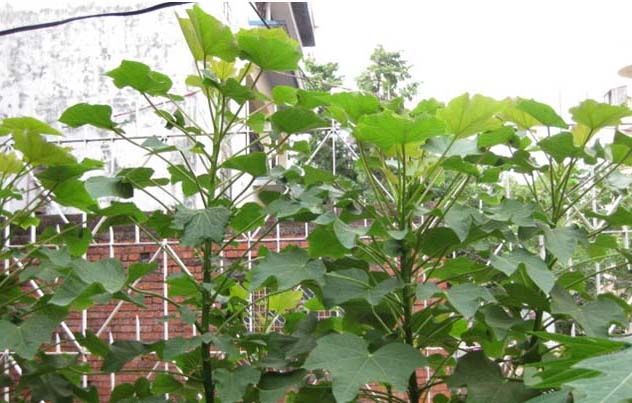
Prospect for second generation biofuel crops
Renewable energy is now a burning issue in both developed and developing countries vis-a-vis energy security, climate change and emission mitigation as well as sustainable development. Energy demand and environmental concerns have significantly constrained sustainable development. Biofuels in particular, as an energy source have attracted great attention in the USA, European countries, China, Japan and even India for significant advantages over fossil diesel as biofuel consumption generates less environmental pollutants such as SOx and NOx and mitigates CO2 emission. Bangladesh, however, has been detached from this issue till recent times.
For many years, I have been researching with different breeding technologies (seedling, stem cutting, grafting and tissue culture) of important energy crops to make sustainable biomass feedstock for the production of renewable energy in the form of biofuel. They may be categorized as first generation biofuel (produced from food crops), second generation biofuel (generated from non food crops) or third generation biofuel (algae).
Jatropha curcas and Castor bean are second generation biofuel crops, which are drought resistant, perennial and grow well in marginal or poor soil. These are easy to establish, grow relatively quickly and produce oil bearing seeds for about 30-50 years. As they are non-food crop and can grow in poor soil, so there is no debate on food verses fuel. It grows almost everywhere, even on gravelly, sandy and saline soils. The leaves shed during the winter months form mulch around the base of the plant. The organic matter from shed leaves enhance earthworm activity in soil around the root zone of the plants which improves fertility of the soil.
The plants grow wild in forests and fields, and are considered as wild or unwanted. Local people are unaware about their life span, uses and economic values. The plants can live for many years and produce huge amounts of seeds every year, from which biofuel can be easily produced. This will meet the increasing demand for fuel in the country, which is currently not possible from any other renewable energy sources.
To combat our energy depletion, Jatropha or Castor based-biodiesel emits around 80% less CO2 and 100% SO2 than the expensive and imported fossil fuel. In addition to global climate change and excess of green-house gases, it addresses deforestation issues as it utilizes infertile, loamy, harsh and fallow lands for production. The seeds contain about 37-50% oil which can be combusted as fuel without being refined. It burns with clear smoke-free flame, tested successfully as fuel in diesel engines. The by-products are also useful as the press cake or seed cake can be used as good organic fertilizer containing Nitrogen, Potassium, Phosphorus and micronutrients.
These two valuable multipurpose crops also help to alleviate soil degradation, desertification and deforestation. Besides the fuel and fertilizer, biogas can also be produced. From the by-products, ingredients for soap, cosmetics and medicinal uses can be derived and hence, they deserve specific attention. From an economic standpoint, it contributes to rural income generation, thereby reducing poverty. It also helps provide jobs to rural men and women and promotes their financial independence, especially in an agrarian nation like Bangladesh.
The fuel is safe in storage as they have a flash point higher than the fossil diesel fuel. Also their viscosity is slightly lower than the fossil diesel which is a good criterion for smooth flow of the oil through the injector in machines. Converting biomass feedstock to biofuels is an environmentally friendly process. Because of their compatibility with the natural carbon cycle, biofuel offer the most beneficial alternative for reducing greenhouse gases from the transportation sector. When we use biofuel instead of gasoline in transportation, we help reduce atmospheric CO2 in three ways:
(1) we avoid the emissions associated with gasoline;
(2) we allow the CO2 content of the fossil fuels to remain in storage; and
(3) we provide a mechanism for CO2 absorption by growing new biomass for fuels.
Aviation fuels are also widely substituted by biofuels produced from jartopha or castor oil. To meet the increasing demand for the jet fuels biodiesel can be blended with the jet fuel since it has lower freezing point then jet fuel. In December 2008, New Zealand tested Jatropha fuels with Houston based air flights and Japan Air also did the same. In 2009, NASA tested and evaluated the potential use of castor oil as a viable and sustainable feedstock for production of bio jet fuel. In 2011, China made similar breakthroughs.
The key to the future of biodiesel is finding inexpensive feedstock that can be grown by farmers of Bangladesh on unused agricultural land and Jatropha and Castor are the two important and promising alternative crops which can certainly reduce our future dependence on oil imports. The country is also faced with severe energy crisis for its growing population. So Jatropha and castor could be introduced as the soils of Bangladesh and its climatic condition are suitable for commercial cultivation. Moreover, second generation plants will not lead to food shortages as they are inedible by both humans and cattle and will be grown on lands which are not suitable for traditional farming.
Since the plants have long lifetime, it is key in producing oils and providing many other beneficial and useful materials over an extended period, all the while sequestering CO2 from the atmosphere.
The waste lands, and other uplands including the huge area of Chittagong hill tracts, low land, lake and riverside can be easily taken under consideration for biofuel cultivation. The plant-seed oil can be directly used to engines especially farming machinery in villages without any modification of the oil structure. Jatropha cultivation will be more profitable and land productivity can be increased many folds in comparison to other crops cultivation in Bangladesh.

Leave a Comment